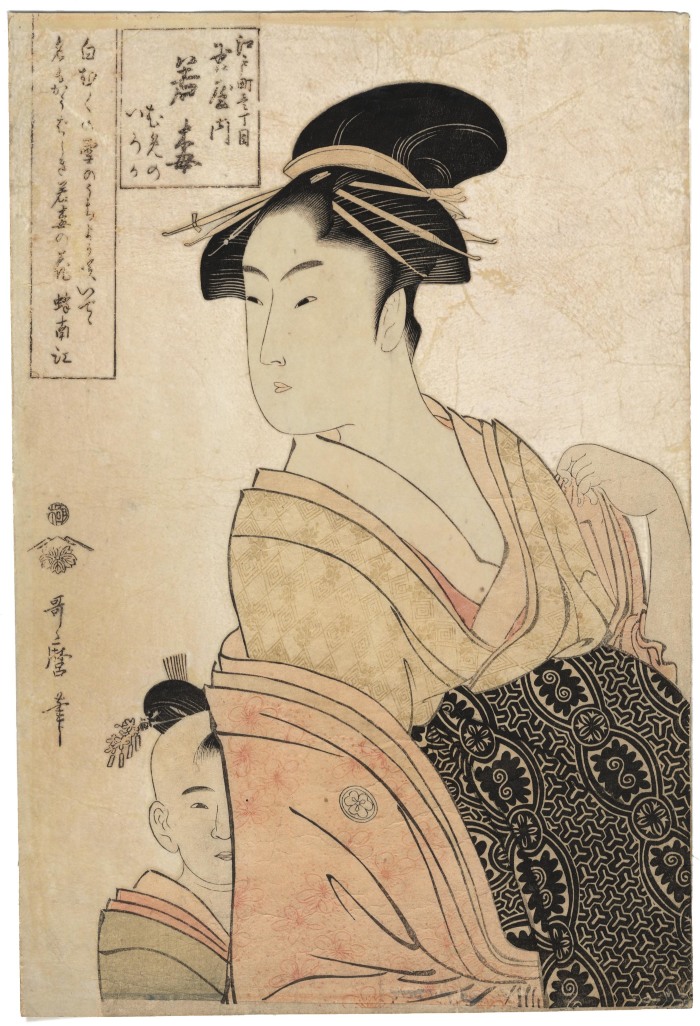Kitagawa Utamaro (喜多川歌麿) (artist ca 1753 – 1806)
Wakaume (若梅) of the Tamaya (玉屋) in Edo-machi itchōme (江戸町壱丁目), kamuro Mumeno (むめの) and Iroka (いろか) (Edo-machi itchōme, Tamaya uchi Wakaume Mumeno Iroka)
ca 1793 – 1794
9.75 in x 14.25 in (Overall dimensions) Japanese woodblock print with mica ground
Signed Utamaro hitsu 歌麿筆
Publisher Tsutaya Jūzaburō (Marks 555 - seal 03-001)
Museum of Fine Arts, Boston - first example
Museum of Fine Arts, Boston - second example
Honolulu Museum
Ritsumeikan University - in black and white
Art Institute of Chicago The print Courtesan Wakaume from the Tamaya is one of Utamaro's masterpieces.
Courtesan Wakaume from the Tamaya in Edomachi 1-chome (c. 1793-1794). Hair heavy with golden pins, the stunning Wakaume turns her head to glance behind her. She belongs to the highest rank of courtesan, the zashiki-mochi, or "having-her-own-suite" rank in the Yoshiwara's Tamaya brothel. Though the cartouche identifies two kamuro, or child attendants, only one can be seen peeking out from behind Wakaume's peach-colored kimono. One cartouche identifies the members of the scene, while a second cartouche presents a kyoka, or "comical poem," by Hachi no Nanko. The verse celebrates the famous beauty Wakaume (若梅, literally young plum):
| 白むくの | White |
| 雪のうちより | From the snow |
| 咲いでゝ | Blossoming |
| 名もかうばしき | Even her name |
| 若梅の花 | Wakaume flower |
The work boasts good color, very good impression and state, but the luxury of this printing rests in the pink mica ground. This iridescent background enhances the elegance of the high-ranking beauty and Utamaro's exquisite composition. Printed straight to the paper, the ground mica created a silver-white surface, yet the printer could manipulate this effect by printing a color beneath the mica. In the case of Utamaro's Wakaume from Tamaya, the iridescent pink likely resulted from the under printing of a safflower rose. As mica is particularly vulnerable to humidity and handling, it is stunning that the mica ground remains so beautifully intact on this print.
****
Illustrated in color in The Passionate Art of Kitagawa Utamaro, plates volume, p. 70, #127. Timothy Clark wrote:
Wakaume was of the zashiki-mochi ("having her own suite") rank in the han magaki (half-lattice) brothel run by Tamaya Yahachi on the right side of Edō-chō 1-chōme, as you entered the street from Naka-no-chō. (This brothel was commonly known as the Yahachi Tamaya, to distinguish it from the several other establishments with the name Tamaya.) Together with Makiginu she was the high-ranked woman in this particular house, though somewhat lower in status than the high-ranked courtesans of more exclusive houses such as the Kado-Tamaya ("Corner Tamaya), Matsubaya or Ōgiya. Apparently a famous courtesan, she was frequently portrayed in Ukiyo-e prints. Nevertheless, it is hard to imagine this three-print set as being a commercial venture by the publisher Tsutaya, and it seems more likely they were sponsored.... The kyōka in the oblong poem-slip is by Hachi no Nankō and plays on the literal meaning of Wakaume's name, White Plum: "Blossoming from out of/Her snow white robe,/Even her name is fragrant -/The flower Wakaume [White Plum]".****
There is another copy of this print in the Japan Ukiyo-e Museum (日本浮世絵博物館).
Tsutaya Jūzaburō (蔦屋重三郎) (publisher)
beautiful women (bijin-ga - 美人画) (genre)
